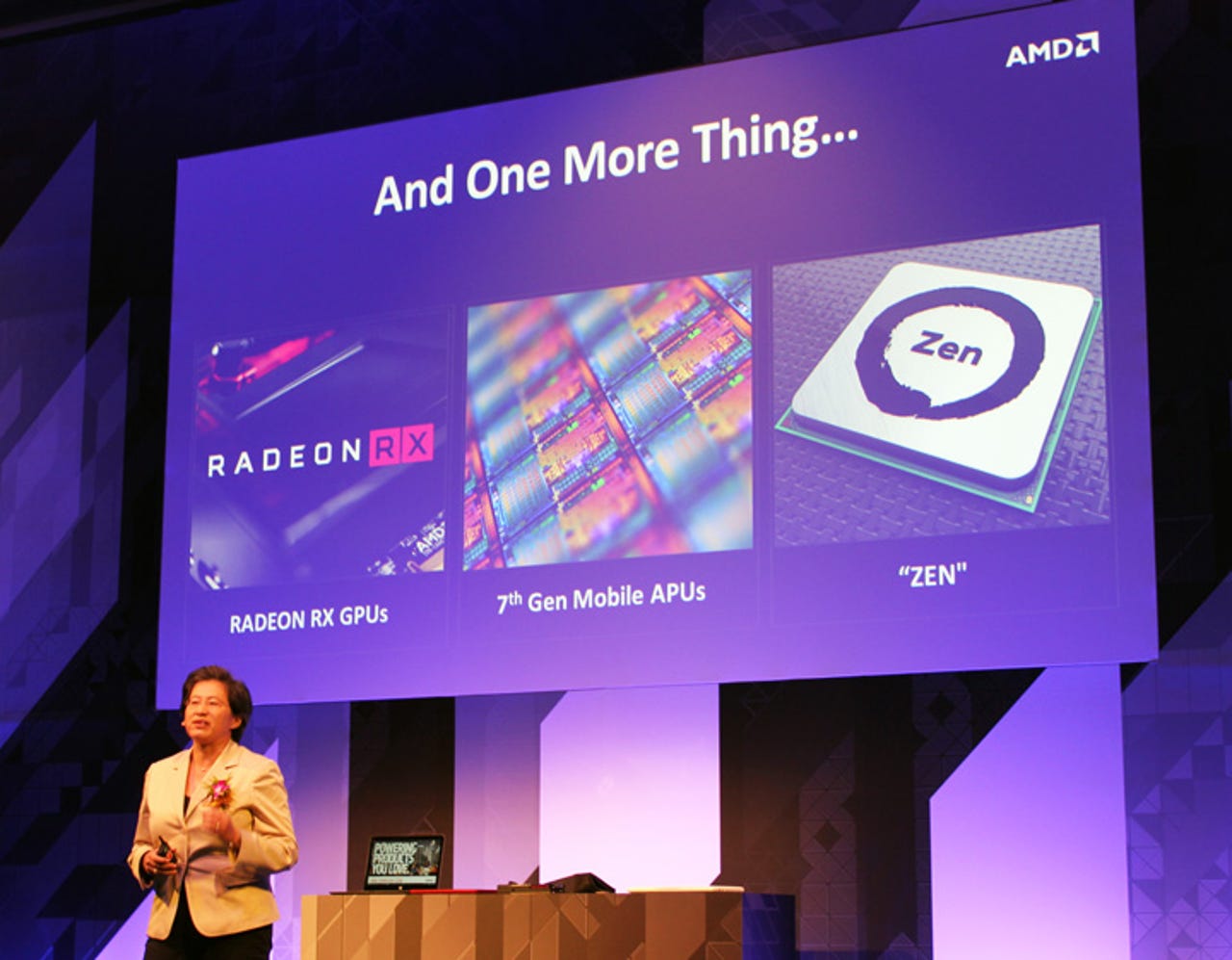Computex 2016: AMD inches closer to Zen, announces Polaris graphics and new APUs


AMD President and CEO Lisa Su at the company's Computex 2016 press conference.
At its Computex press conference, AMD announced the expected Polaris graphics and the latest generation of its A-Series and E-Series processors, which combine x86 CPU cores with Radeon graphics on the same chip. But the big surprise was an update on Summit Ridge, which will be AMD's first processor to use its upcoming Zen architecture.
"Zen is very, very special project and product for AMD," President and CEO Lisa Su said. "We are in the early stages of bring-up but the product looks really good."
For the first time, AMD showed a video that was created on a system running a Summit Ridge processor. Su said Summit Ridge will be manufactured using 3D or FinFET transistors, will have up to eight cores and 16 threads, and deliver a 40 percent increase in instructions per cycle. Summit Ridge will use a new AM4 platform, which Su billed as the company's return to high-performance desktops.
AMD will send the first Summit Ridge sample chips to "priority customers" in the next few weeks, with wider sampling in the third quarter. That sounds good but it's worth noting that AMD did not commit to an exact launch date. The desktop processor will be followed by versions for servers, APUs (Accelerated Processing Units) that combine Zen CPU cores and Radeon graphics, and eventually embedded.
Polaris was not a surprise, but it is still noteworthy since it is AMD's first GPU to use new process technology with FinFETs and it promises to bring higher performance down into mid-range systems. The first Polaris GPUs, the Radeon RX Series, will start at $200. The Radeon RX480 will have 36 CUs (Compute Units), 4- or 8GB of GDDR5 memory and 256GBps of bandwidth, and deliver more than five teraflops of performance. AMD said it is also the company's most power-efficient GPU ever delivering 1.7x better performance per watt than its current GPUs thanks to both the FinFET process and architectural improvements
AMD's Raja Koduri introduces the Radeon RX Series "Polaris" GPUs.
The Radeon RX Series supports the newer DirectX 12 and Vulkan graphics APIs, as well as AMD's FreeSync dynamic refresh-rate technology for smooth gameplay. In a video, ID Software talked about how it using the Vulkan APIs on games such as Doom to deliver a good experience for gamers on all budgets. High-end GPUs using Vulkan will deliver performance in excess of 200 frames per second, but the bottom line, they said, is that gamers won't need $700 graphics card for great gaming.
That was a thinly-veiled reference to Nvidia's recently-announced GeForce GTX 1080, which is the fastest single GPU on the market. Interestingly AMD made a pitch for using two Radeon RX480 GPUs, at a cost of less than $500, to deliver the same or better performance than a $700 GTX 1080. AMD's tests on Ashes of the Singularity, a DX12 game, showed that dual Radeon RX480s delivered slightly higher frame rates at much lower GPU utilization.
The majority of gamers today buy graphics cards than cost $300 or less. For them, virtual reality is too expensive. A big part of the Polaris strategy is to "democratize" VR and capture the first 100 million users. "VR should be everywhere and it should be for everyone," said Raja Koduri, the Senior Vice President and Chief Architect of the Radeon Technologies Group, said. "And it should start now." The Radeon RX Series will include GPUs that are certified for use with the Oculus Rift and HTC Vive VR headsets.
The first Polaris GPUs will be on shelves on June 29 and Koduri said more information on the Radeon RX Series will be coming out in the next few weeks.
The final announcement was AMD's latest generation of APUs, including the "Bristol Ridge" A10, A12 and FX Series APUs with up to four Excavator x86 cores, and the lower power "Stoney Ridge" versions for low-cost laptops. As part of the launch, AMD also introduced a new A9 Series--along with the budget E2 and A6 Stoney Ridge APUs--to bring better performance down into the sub-$400 notebook market.
Jim Anderson, Senior Vice President and head of the Computing and Graphics division, noted that the same graphics technology in the latest Radeon GPUs trickles down into the mobile processors. That includes 4K HEVC video acceleration, support for AMD FreeSync, and better gaming performance on popular games such as League of Legends than Intel Core i7 processors.
The gains in CPU performance are less dramatic because Bristol Ridge uses the same Excavator x86 cores. The company says it delivers 50 percent higher CPU performance than "just a few years ago" but the gains over current Carrizo APUs are relatively minor. The new APUs are, however, more energy efficient thanks to support for low-power DDR4 memory and an updated version of Adaptive Voltage and Frequency Scaling (AVFS). AMD says this has resulted in a 25 percent improvement in performance per watt versus the current APUs.
Acer, Asus, Dell, HP and Lenovo are all offering system using these new A-Series processors. HP's Josephine Tan, talked about how the company was using AMD processors in mainstream laptops, premium convertibles and Omen gaming PCs while Dell's Ray Wah showed the Inspiron 5000 Series, a thin $400 laptop with an optical drive. Finally Microsoft's Matt Perry gave a pitch for Windows 10 and said the company has been working closely with AMD to make sure the new A-Series APUs will work well with the Windows 10 Anniversary Update due out this summer.
AMD's Jim Anderson said the new Bristol Ridge APUs deliver better gaming performance than Intel's Core i7 processors.